Passing by all manner of things in the real world – and being passed by them – is an important canine good manners skill. Unfortunately, it seems to be one that is absent in many dogs’ behavior repertoires. Some training classes don’t address this behavior challenge at all. Others do, but owners don’t always take time to generalize the behavior outside the training center. Their dogs, in the real world, still bounce over to greet any and all comers on the street, or on the opposite end of the continuum, shy away from people and things that frighten them.
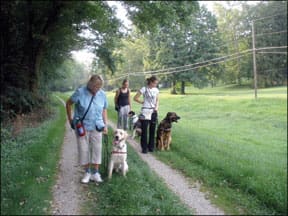
288
My “Downtown Hound” class graduated in early September with a celebration at Nutter’s Ice Cream in nearby Sharpsburg. It was a 90 degree-plus day with high humidity, and the ice cream parlor was a popular spot in this small Maryland community. I watched with pride as the four dogs lay quietly at their humans’ feet, happily downing the occasional offered dog treat while their owners licked ice cream cones. More importantly, they rested quietly as people walked by with strollers and dogs, kids on skateboards flew past noisily, and motorcycles, trucks, and cars rumbled by a few feet away on busy Main Street.
I offer this class for students who want to a structured opportunity to work on their dogs’ real-life skills. It’s a summertime-only class; we take advantage of daylight savings time to give us enough light for evening get-togethers. We go to a variety of locations: the local outlet mall, a dog-friendly outdoor cafe, Hagerstown City Park, the C&O Canal, and downtown Sharpsburg. In each venue, the focus is on polite behavior as we pass by whoever else might be there: Shoppers at the mall; evening strollers, bird watchers, ducks, and swans at the park; walkers, bikers, joggers, and fisher-people at the canal; and town folks in Sharpsburg. And of course, occasional other dogs on leashes.
In order to participate in Downtown Hound, dog/human teams have to pass my Peaceable Paws Intermediate Class or, if they trained elsewhere, pass an evaluation. I want to be sure their leash-walking and owner-focus skills are solid enough to handle the excitement of the real world.
The first session is a refresher course here on my farm. Class members hike on the trails and practice passing each other. When the dogs pay attention to their handlers (over all else), the handlers respond with a lot of clicks – a noise made by a small plastic box called a clicker, used to mark the moment a dog exhibits a behavior we want – and treats, to reward and reinforce the attention-paying behavior.
We set up the teams six to eight feet apart in an open meadow with the dogs on a sit-stay or down-stay. One at a time, the handlers ask their dogs to heel, weaving in and out of the living weave poles. As each canine and human pair takes their place at the end of the row, another pair walks by them. We also practice recalls in an open field, with the dogs on long lines (and off-leash when possible), to tune up that important skill, just in case a leash gets dropped in the real world and a recall is needed. The following six weeks we meet off-property.
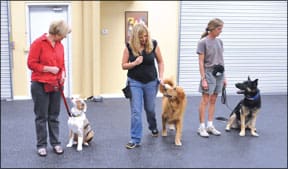
288
Five tools for polite passing
Our first outing is usually to the outlet mall. The sidewalks there are wide and there are lots of grassy spaces, so it’s easy for us to avoid people if one of our dogs is behaving in a rude manner.
Dogs should never greet a passer-by unless he’s been invited to do so, and even then the greeting should be polite – a “say please” sit. I remind the group that they are supposed to be good canine ambassadors, always on the alert for human body language that says an approaching person isn’t comfortable with dogs, and giving those people an extra wide berth.
Dog-dog interactions follow similar rules. Our canine pals should walk politely past another dog on the sidewalk, greeting only if and when both human parties agree to a meeting and the dogs are given permission to do so (hence our “living weave poles” exercise).
The key to polite passing is focused attention – assuming the dog already has reasonably polite leash-walking skills (see “Good Dog Walking,” Whole Dog Journal March 2007). If you can keep your dog focused on you, he will walk politely; it’s as simple as that. Simple, but definitely not easy! Here are the exercises we practice in my training center’s basic classes to lay a focus foundation for real life:
• Good lookin’: When dogs come to class for the first time, they are understandably distracted – just as your dog is when he gets to go out with you in the big wide world. Lots of very exciting stuff happening! It’s ineffective to beg and plead for your dog’s attention. Instead, I tell my students to sit in a chair and wait. The instant their dog looks at them or even glances in their general direction, they should click their clickers and feed their dogs a treat.
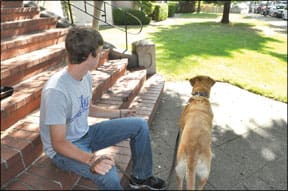
288
You can do the same with your dog when you take him out in public. Sit on a folding chair on your front lawn, or on a bench in a park, or in front of the post office, and wait. The instant your dog looks at you, or near you, click and feed him a high value treat. You’re reinforcing his offered attention, teaching your dog that if he chooses to look at you he can make you click and give him a treat.
Over time, “shape” this behavior (reward successively more precise behavior) for longer eye contact, and then for making eye contact with you when you’re both walking. If he’s making eye contact with you when you pass someone on the sidewalk, he can’t be looking at them!
• Name game: If your dog’s not offering attention, you can always ask for it – if you’ve taught him that his name means “Look at me for something wonderful!” Say his name, then feed him a tasty treat.
Repeat this game regularly, until your dog instantly swivels his head toward you at the sound of his name. Then practice with increasing levels of distraction. Now you can get his attention, if he doesn’t offer it.
• Zen attention: Getting your dog’s attention is one thing; keeping it is sometimes an entirely different matter. This exercise makes it clear to your dog that eye contact with you, not just looking at the treat, is what gets reinforced. The game also allows you to “shape” for duration.
With your dog sitting in front of you, hold a treat out at arms’ length to the side. He will likely watch the treat. Just wait. Here’s the Zen part. In order to get the treat he has to look away from it – back at you. The instant he looks at you (as if to say, “Hey Mom, what’s the deal here?”) you click and feed him the treat. Then do it again. Most dogs figure this out amazingly quickly. When he comprehends that looking at you – not the treat – gets the treat, you can add your “Watch me” cue, and start shaping for longer duration of eye contact.
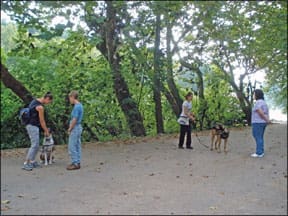
288
• Me, not that: Now it’s distraction time. With your “Watch me” cue solidly installed, ask a family member or friend to walk past while you’re reinforcing your dog for looking at you. Use a high rate of reinforcement at first (click and treat a lot) – then decrease the frequency as your dog figures out the game. If he looks away, use his name or your “Watch me” cue to get his attention back. Click and treat!
Gradually increase the intensity of the distraction: Start walking with your own dog toward your human distraction, have your friend whistle, clap his hands, or jingle car keys while walking past, then jog, then bounce a ball – get creative! Now take him to a low-distraction public place to start your real-life practice. With each successful session under your belt, you can plan for a more distracting venue the next time.
• The Premack look: Perhaps your dog is a social butterfly and really wants to greet the people and other dogs you’re asking him to pass. You can use something called the Premack Principle to your advantage, by teaching him that polite passing sometimes gets reinforced by the opportunity to greet. Premack, also referred to as “Grandma’s Law,” says you can use a more desirable behavior to reinforce a less desirable one (you have to eat your vegetables before you can have dessert).
To use the Premack Principle for polite passing, start by hiding high-value treats in an open area (remember where you hid them!), and practicing polite leash walking in that area. Occasionally when your dog is giving you wonderful focused attention, say “Find it!” and run with him to the nearest hidden treat. You’re teaching him that great attention makes unexpected treasures happen.
Now bring your friend back into the picture. Practice your polite passing, and occasionally after an excellent pass-by, when you’re several feet beyond the person say “Go say hi!” and turn around to let him (politely) greet. In public, when someone asks if they can pet your dog, ask them to play this wonderful game with you. Be sure to do the greeting randomly (sometimes but not always), and vary the distance you pass the other person before you greet, so your dog doesn’t start expecting to greet everyone he passes.
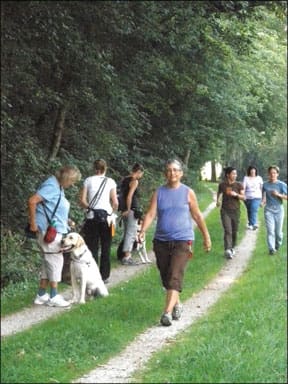
288
With these five strategies for gaining your dog’s attention at your disposal, you and your dog should be able to skate through any public polite passing opportunities. That is, unless your dog is fearful. If you’re having difficulty passing people, dogs and/or things on the street because your dog’s afraid of them, you’re looking at a whole different challenge – passing scary stuff.
Passing other dogs
Perhaps the most frequent transgression of canine passing etiquette occurs when dog owners routinely allow their canine charges to dash up to every other dog they see, often despite the other owner’s obvious and desperate attempts to avoid interaction.
“It’s okay,” they say. “My dog’s friendly!”
“Friendly” isn’t the point. The dog being approached may be fearful of other dogs, or may react poorly to dogs getting in his space – or face. He may be recovering from an injury or surgery. The human being approached may simply choose not to have her dog interact with others while on leash, for a myriad of valid reasons. Whatever the case may be, uninvited on-leash greeting is simply rude behavior.
The five tools for polite passing are doubly, maybe even triply important when you and your dog are passing others with their dogs. The ultimate challenge is keeping your dog focused on you and passing politely even when the other dog is doing everything in his power to get your dog to engage. Now there’s good attention training!
Passing scary stuff
The dog who is fearful may exhibit one of a number of behaviors when asked to pass his fear-eliciting stimuli. He may cling to his owner’s side, seeking protection, trying to pass the monster as quickly as possible. He may try to flee, running away to the end of the leash and thrashing in panic when he feels the restraint. Or he may become defensively aggressive, offering a display of teeth and noise to try to ward off the scary thing. All of these behaviors are embarrassing and unacceptable in public, and the third one can pose a significant threat to the safety of passers-by. The fear-aggressive dog is quite likely to bite if he feels sufficiently trapped or threatened.
Ideally, you’ll avoid over-threshold public exposures for a dog who is fearful, until your behavior modification efforts succeed in building canine confidence using either counter-conditioning and desensitization (see “Fear Itself,” Whole Dog Journal April 2007), operant conditioning (see “Building Better Behaviors,” May 2008), or a combination of the two. In a pinch, feeding your dog some high-value treats while retreating to a safe distance or moving swiftly past the scary thing can get you and your fearful dog out of a tight spot. If your dog loves targeting (see “Right on Target,” February 2006), you can also use “Touch!” to temporarily give him a little more confidence and improve his emotional state while keeping him focused on you and the target you’re asking him to touch with his nose or a paw.
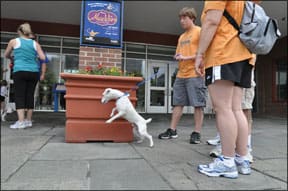
288
Note: Do not try to have the scary person feed your dog treats. This is a good way to get someone bitten: the dog is coaxed over threshold and temporarily distracted by the temptation of the high-value treat, but after he eats it he realizes he’s too close to the scary person and may be compelled to bite.
Emergency escape
Alternatively, if you know that hurrying past a scary person or thing is not a viable option, an emergency escape can get you and your frightened Fido out of a perilous predicament. Rather than passing, you’re going to turn and run the other way. First, however, you’ll take the time to teach your dog that “run away fast!” is a really fun game.
Pick a cue, such as “Run awaaaay!” that will easily pop into your brain in times of stress. In the comfort of your dog’s own familiar surroundings, practice polite leash walking. Occasionally, unexpectedly, announce, “Run awaaaay!” while you whirl and dash off as fast as you can in the opposite direction with your dog bounding along beside you. After you’ve run 20 to 30 feet, sometimes fling a handful of treats out in front of your dog, sometimes whip out a ball and throw it for him to chase, and sometimes pull out a hidden rope toy and play a rousing round of tug.
Your goal is to make this an absolutely wonderful, fun game for him. When you succeed, you’ll have a powerful tool for those emergency encounters; your “Run awaaaaaay!” cue will take advantage of his classical “Yay, fun!” association with the game to help manage his emotional state, and his operant response to the cue will get the two of you safely away from the scary thing.
Of course, fearful dogs aren’t good candidates for a Downtown Hound class. One of our class members, a Spitz named Dexter who showed up last winter as a stray on the doorstep of his owners-to-be, started out with some fear issues in our good manners classes. Thanks to the diligent work of his human, Maryann Hamilton, he overcame his fears and was able to graduate from the class with honors.
Our class also included three dogs without fear-related behaviors: Walden, a year-old Labrador Retriever/service dog-in-training; Harley, a hound-mix practicing his public good manners skills partly in preparation for upcoming rally trials, and Mo, an 11-month-old, 100-pound Rottweiler/Shepherd-mix, who needs good manners for his owner who doesn’t weigh much more than he does.
All of the teams became quite skilled at politely passing each other, strangers, and other dogs in public places. You could say they all “passed” the class with flying colors!
Pat Miller, CPDT, is Whole Dog Journal’s Training Editor. Miller lives in Hagerstown, Maryland, site of her Peaceable Paws training center. Pat is also author of The Power of Positive Dog Training; Positive Perspectives: Love Your Dog, Train Your Dog; Positive Perspectives II: Know Your Dog, Train Your Dog; and Play with Your Dog.



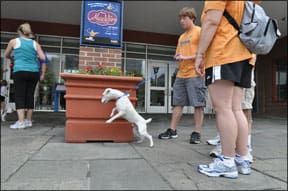
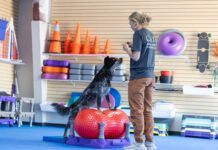


Hi there yeah those classes are awesome for you dog when you go out in the city. I love it…